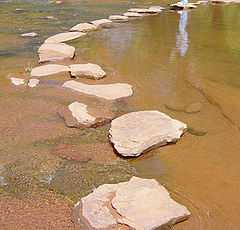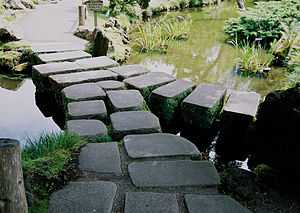Step-stone bridge
 A rustic Step-Stone Bridge across a stream. | |
| Ancestor | None, this is one of the few foundational types, but see also: ford (crossing). |
|---|---|
| Related | Natural Stepping Stone stream crossing |
| Descendant | Clapper bridge, Zig-zag bridge, Log bridge |
| Carries | Pedestrians |
| Span range | Has no spans, but stones must be spaced to allow water flow and a comfortable step or leap |
| Material | Selected stone |
| Movable | No |
| Design effort | Low-rustic to Artisan applied art design |
| Falsework required | No |
A step-stone bridge or stepping stones is a simple bridge or causeway that allows a pedestrian to cross a natural watercourse or pond, or a garden's water feature where water is allowed to course between stone steps. Unlike other bridges it has no spans. Step-stone bridges, along with log bridges, are likely to be the oldest bridge types. They are often built by hikers and disarranged during periods of high, fast water.
Garden crossings


In landscape and garden design, step-stone bridges cross natural landscape style and Asian-themed water features and "dry landscape" symbolic "water gardens."
Asian gardens
Step-stone bridges are seen in traditional and contemporary Chinese and Japanese gardens, and Zen rock gardens. It is a principal bridge types in these gardens, along with Moon bridges.
A Zig-zag bridge was traditionally used to allow the pedestrian to fool and evade "evil spirits" following them, and used in Zen gardens for mindfulness practice.
Euro-American gardens
In classic and formal western culture traditional water garden and reflecting pool landscapes the stepping stones may be crisp rectilinear forms of stone with honed or flame-treated surfaces.
Stones wider than thick may be securely mounted in a "mushroom with stalk" method, with the support stem hidden below the water's surface for a floating aesthetic.
Modernist urban park landscapes, such as the Seattle Freeway Park and Keller Fountain Park, Downtown Portland with elevation changes of the massive step stones—by landscape architect Lawrence Halprin—continue the evolution of the step-stone bridge and water.
Construction and aesthetics
Natural step-stones are usually quarried from rough blocks or large flat river rocks worn smooth. Some step-stone bridges are made with cast stone or concrete in cube or faux-natural forms. The top surface may be smoothed (or carefully roughened) in an even plane by a stonemason to minimize tripping.
Historic step-stone bridge

The Drukken Steps in the Eglinton Woods of North Ayrshire in Scotland were a favourite haunt of the renowned poet Robert Burns and his companion Richard Brown, whilst the two were living in Irvine from 1781 to 1782.[1]
The name "Drukken" steps derives from a person's gait as they stepped from stone to stone whilst crossing the Red Burn. Seven or more stones were originally set in the Red Burn which was much wider than now (2009).[2]
Burns himself used the Scots spelling "Drucken" rather than "Drukken".[3] The ruins of the Drukken Steps are now found in the Eglinton Country Park.
Gallery
-

A step-stone bridge crossing the "dry landscape pond" of Taisan-ji, Kobe, Japan.
-

Freeway Park-Downtown Seattle-Washington (U.S. state)
-

Freeway Park-Downtown Seattle-Washington (U.S. state)
-

The stepping stones in the Rothay, Lake District, England.
See also
| Wikimedia Commons has media related to Step-stone bridges. |
- Clapper bridge
- Footbridge
- Ford (crossing)
- Kulgrinda
References
- ↑ Love, page 60.
- ↑ King.
- ↑ Scotch Drink